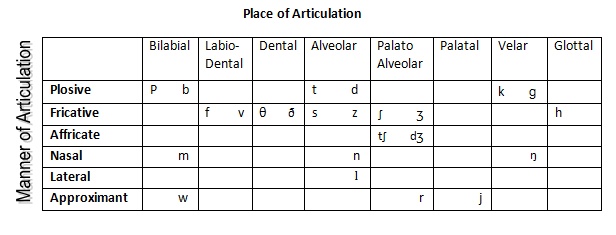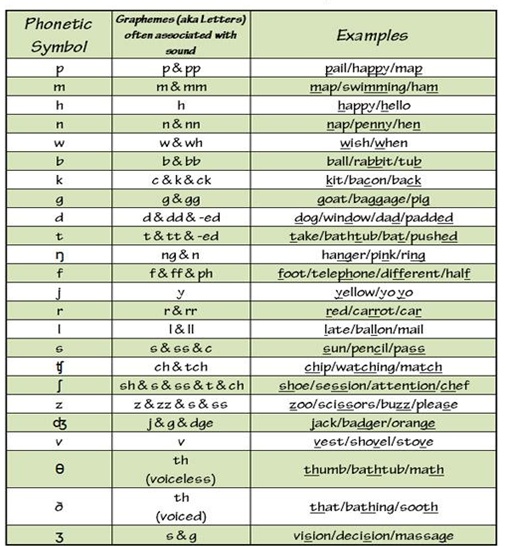Consonants
Human speech sounds produced by the stopping or obstructing of air stream are called ‘consonants’. J. D. O’Conner says:
“The consonants form the bones, the skeleton of
English words and give them their basic shape.”
Accents of English are different in different parts of the world. These differences are mainly the result of differences in the sounds of vowels; the consonants are spoken in very much the same way wherever English is spoken. So, mistake in consonant sound will make the speech unintelligible.
In English, there are twenty-four consonants. Now we discuss, consonant sounds with the help of articulation which includes information about three things:
(a) Voiced or Voiceless (b) Place of Articulation (c) Manner of Articulation
(a) Voiced or Voiceless:
Consonant sounds are either voiced or voiceless. If the vocal cords are open and allow free passage of air, the consonant sound will be voiceless, and if the cords are in vibration, the sound will be voiced e.g. if we plug our ears with our fingers and say these two words ‘pea’ and ‘bee’ alternately, we find that there is a greater amount of noise inside our ears in the case of latter word—‘bee’; while in saying ‘pea’, they vibrate only for the vowel sound.
This can also be verified by putting our fingers on ‘Adam’s apple’ while saying these two sounds. Hence we see that initial sound in ‘bee’ is voiced while that in ‘pea’, it is voiceless. In English 15 consonants are voiced and 9 consonants are voiceless.
Voiced consonants= /b/, /m/, /w/, /v/, /ð/, /d/, /z/, /n/, /1/, /ʒ/, /dʒ/, /r/, /j/, /g/, /ŋ /.
Voiceless consonants= /p/, /f/, /θ/, /t/, /s/, /∫/, /t∫/, /k/, /h/.
(b) Place of Articulation:
Consonants are also studied according to the place of articulation. In it, we look at the vocal organs which are responsible for producing consonant sounds. These are discussed as under:
1. Bilabials or Bilabial Sounds:
Bilabial sounds are produced by the two lips (touching together). These sounds are: /p/, /b/, /m/, /w/.
2. Labio-dental Sounds:
Labio-dental sounds are produced when lower lip and upper front teeth press together. These sounds are: /f/, /v/.
3. Dental Sounds:
Dental sounds are produced when the tongue is between the upper front and lower front teeth. These sounds are: /θ/, /ð/.
4. Alveolar Sounds:
Alveolar sounds are produced when the tip of the tongue touches the alveolar ridge. These sounds are: /t/, /d/, /s/, /z/, /n/, /1/.
5. Palato Alveolar Sounds:
When the blade of the tongue touches the back of the alveolar ridge, the sounds produced are called palato-alveolar sounds. These sounds are: /∫/, /ʒ/, /t∫/, /dʒ/, /r/.
6. Palatal Sounds:
The palatal sound is produced when front of the tongue touches the hard palate. This sound is /j/.
7. Velar Sounds:
When the back of the tongue touches the soft palate, the sounds produced are called velar sounds. These sounds are: /k/, /g/, /ŋ /.
8. Glottal Sound:
The sound produced by the glottis, (V-shaped opening of the vocal cords) is called glottal sound. This sound is /h/.
(C) Manner of Articulation:
How consonants are produced by our vocal organs is called manner of articulation.
1. Plosives:
Plosives are produced when there is a complete closure at some point in the vocal track, behind which the air pressure builds up and it is released explosively. These are also called oral stops. These sounds are: /p/, /b/, /t/, /d/, /k/, /g/.
2. Fricatives:
When fricatives are produced, the air escapes through a small passage and makes a hissing sound. These sounds are; /f/, /v/, /θ/, /ð/, /s/, /z/, /∫/, /ʒ/, /h/.
3. Affricates:
Affricates are rather complex consonants. They begin as plosives and end as fricatives. These sounds are: /t∫/, /d3/.
4. Nasal Sounds:
For the production of the nasal sound, the soft palate must be lowered. However, there is complete closure at some point in the mouth and the air does not pass through the mouth, rather it escapes through the nose. These consonants are also called nasal stops. These sounds are: /m/, /n/, /ŋ /.
5. Lateral:
One English consonant / l / is formed laterally, i.e. instead of the air passing from the centre of the mouth it passes round the side of an obstruction set up in the centre.
6. Approximant or Gliding Consonant:
There are three consonants which consist of a quick, smooth, non-frictional glide towards a following vowel sound. These consonants are: /j/, /w/, /r/. These sounds are also called ‘semi-vowels’.
The above detail about consonants makes it clear that consonants are produced by stopping or obstructing the air stream at some point in the mouth. The following chart explains the consonants briefly:

We can see from the chart, voiceless sounds are on the left side of the box (called ‘Fortis’) and voiced consonants are on the right (called ‘Lenis’).




